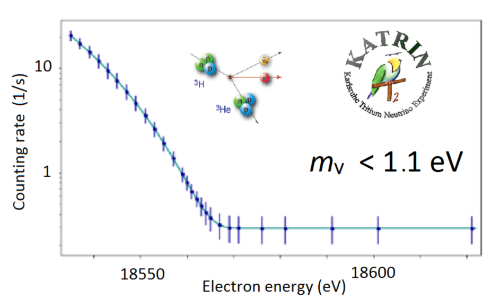
The first scientific result of the international neutrino experiment KATRIN
16. 09. 2019
Neutrinos are important elementary particles, e.g. the thermonuclear reaction in the Sun ‒ one of the conditions for living on our Earth ‒ could not proceed without neutrinos. Scientists already succeeded in clarifying various neutrino properties but, regardless many decades effort, they determined only crude limits for the neutrino mass. The international project KATRIN (Karlsruhe Tritium Neutrino experiment) aims to increase the sensitivity of “the neutrino weight” by a factor of ten. The scientists in the Nuclear Physics Institute of the Czech Academy of Sciences at Řež, who belong among founders of this unique experiment, have developed for KATRIN precise sources of monoenergetic electrons.
The complex experimental equipment KATRIN was built in the Karlsruhe Institute of Technology (KIT). After completion of extensive test, the first four-week measurement of energy spectrum of electrons released in the radioactive decay of tritium was carried out. The careful analysis of the recorded spectra (left side down picture) resulted in the new upper limit of 1.1 eV on the neutrino mass. Thus, a half of million of the neutrinos weights less than one electron ‒ the second lightest elementary particle. This first scientific result of KATRIN is almost twice better that the previous upper limit achieved after measurements lasting several years. The reason is a hundred time higher sensitivity and five times better energy resolution of KATRIN. Future measurements of KATRIN will further improve our knowledge of the neutrino mass.
Complete NPI of the CAS press release, based on the press release of KATRIN collaboration, you can find here (in Czech language).
Title picture: Main parts of the 70m long experimental setup KATRIN and their role in measurement of the neutrino mass.

Left side picture:
Energy spectrum of electrons from the radioactive decay of tritium measured for 521 hours. The error bar of each of the measured points is increased by a factor of 50 for clarity. The full line describes an expected spectrum shape in the case of zero neutrino mass.
Read also
- The Nuclear Physics Institute of the CAS celebrated its 70th anniversary
- The NPI stand at VědaFest broadcast live on Czech Television
- Second “Day with Theoretical Nuclear Physics” attracted students from across the country
- Martin Schäfer receives Otto Wichterle Award
- NPI organized the ReMade@ARI workshop, focusing on cutting-edge materials characterization and international collaboration
- NPI Co-Organized the 5th Meeting of the EIC International Financial Committee at BNL
- Radiocarbon Dating Reveals Gaps in Elephant Protection
- We are participating in two new projects focused on cosmic rays
- Roman Garba presented his research in Austria and the United Kingdom
- Our Research on Improving Silver Content Measurement in Mushrooms Supported by the AV21 Strategy

